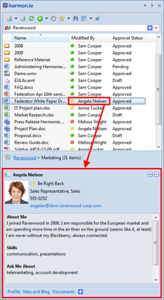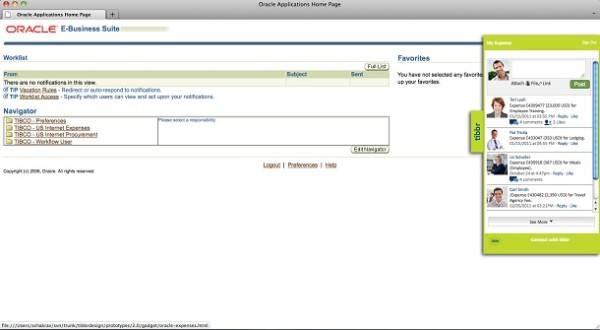When I started professionally covering the enterprise 2.0/social business space just over a year ago it was all very exciting. I had personally witnessed how valuable a workplace microblog/activity stream could be, and I loved learning about all the different companies and the ideas floating around.

But it’s easy to get bored. Despite all the talk about the consumerization of the enterprise, things still move slowly (heck, things don’t really change that much day to day, week to week in the consumer space either). The same few problems seem to be discussed again and again: adoption, security, process, semantics etc. As Dennis Howlett recently wrote: “much of what we are hearing in the social space we’ve heard repeated for at least the last three years. In other words, precious little real progress.”
So it’s always nice to see some incremental progress, and this week brought at least two noteworthy product updates: one from Harmon.ie and one from tibbr. Each company was already doing something interesting, and each has taken its products to the next level.
Harmon.ie Goes Beyond SharePoint in Outlook
We’ve covered Harmon.ie a couple of times. It had a straight forward appeal: end attachment ping pong and get people to actually use SharePoint by bringing SharePoint into Outlook.
Now it’s taking it a step further, and making Harmon.ie into a full social network within Outlook or Lotus Notes by adding users profiles (with info pulled from SharePoint MySite) and activity streams. It’s also fully compatible with Office 365, and can integrate with unified communications tools like Lync.

Adoption is one of those issues we all keep coming back to when we talk about social software in the enterprise. You know that workplace microblog I mentioned earlier? It fell apart. People liked it at first, but it quickly fell into disuse. It was just one more thing to keep track of, one more thing to do. It was on its own page in SharePoint, and it was out of sight and out of mind.
So solutions that try to bring social elements into existing applications, into existing workflows and contexts are the most interesting to me. Besides Harmon.ie, some of these include Qontext, Socialcast and Simplybox. Salesforce.com is trying to pull this off with Chatter (which CA just integrated with its Project and Portfolio Management product), as are SAP with Sales OnDemand and Netsuite with its Qontext and Yammer integrations.
Harmon.ie is even considering how to bring outside social networks like LinkedIn and Twitter into the e-mail client and generate profiles for people outside the company. This would brings it in line with e-mail plugins like Rapportive, Xobni and Microsoft’s own Social Connector. And if it started expanding beyond that by incorporate social media monitoring and engagement tools you could have a full social business solution living right inside your safe, familiar e-mail client that you already use every day.
The danger in Harmon.ie’s approach is that it may end up being a little too safe and comfortable, letting users stay in outdated applications and shoehorning social experiences into platforms ill suited for it.
Harmon.ie’s representatives couldn’t say whether the company is expanding into any other areas, like a stand-alone Web app or the ability to embed into CRM systems, but he Harmon.ie is releasing a mobile app that breaks its activity stream free of Outlook.
tibbr Brings Action to the Activity Stream, and Takes the Activity Stream to Other Apps
TIBCO tibbr, which I covered here, was already pretty interesting. Instead of taking social to existing apps, it tries to aggregate all apps in one stream. It’s going after the universal inbox, a sort of holy grail in digital communications. Another company trying to solve this particular problem is my former employer Attensa.
TIBCO has existing enterprise chops. It also came with an “app store” of various enterprise integrations (such as Oracle, SAP and Salesforce.com). This was a nice contrast to various startups with no enterprise credibility, as well as to SAP’s rather odd choices for integration during the first few months of StreamWorks’ existence.
But there was a problem with tibbr’s approach. The general idea is that you can get someone to take on yet another app because it gives them everything in one place, so they don’t have to juggle between applications anymore. But if people are only notified of something in the activity stream, they’ve still got to bounce back over to their other software to actually take action. So the juggling act persists.
And that’s the problem this release is trying to solve. By enabling users to take action on events from other applications, tibbr 3.0 is trying to get rid of that juggling act. You get a purchase request in the tibbr stream. You authorize it right there, in steam, and move on to the next action.

Still, you probably can’t act on everything within the stream. But tibbr now also has a widget for adding its stream into other application (above). It looks a bit more like Simplybox than Qontext.
The new release also brings unified communications features like voice and instant messaging into the platform, and the ability to embed video.
Closing Thoughts
Will it work out? Unlike Harmon.ie, which is tries to ease users into the world of enterprise social through safe, boring old e-mail interfaces, tibbr is trying to dump people right into the thick of the social world. Either extreme could work or fail. But both are reasonable approaches to take. tibbr can hedge its bets for now with the widget, though it’s going to need to fit more seamlessly into applications than it appears to now. Harmon.ie is going to need to do some hedging of its own by introducing some independent apps. But for right now, it’s a good approach for bringing social into Microsoft shops with an existing investment in SharePoint.
What’s Next?
Adoption isn’t enough. There has to be a point to these sorts of tools. Sameer Patel of the Sovos Groupsaid in a recent talk about on the customer-facing side of social business: “For five years we’ve been engrossed in one giant collaborate group hug, measuring things that don’t keep executives up at night.” He also wrote: “For those who know this community, you will appreciate how significant it is that enterprise social and collaboration practitioners have started to either realize that they need to move beyond measuring nebulous stuff like engagement, ‘getting social,’ productivity and adoption.”
And that is where things are going to have to go next.










